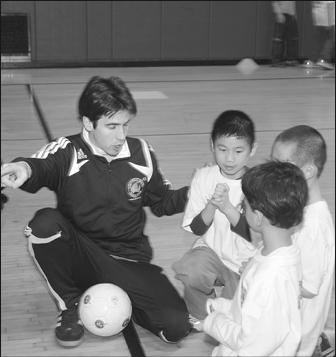By Sebastian Kahnert
Eight-year-old Tim was proudly sporting his white soccer T-shirt on a recent Saturday, and his sparkly white soccer ball left his hands as soon as he entered the gym at P.S. 2, joining 16 other first and second graders for the soccer academy in Chinatown hosted by the Downtown United Soccer Club.
Central City Initiative, a four-year-old citywide effort, began a new program at P.S. 2 six weeks ago. The non-profit organization is sponsoring the free soccer academy and equipped all kids with T-shirts and white soccer balls.
Coach Paul Jeffries, a former professional soccer player from England, welcomed the euphoric youngsters with a game called “Stuck in the Mud.” The players are split up in two teams and the goal is to tag players from the opposite team while dribbling a soccer ball. If a player has been tagged, he or she is “stuck in the mud” and the player can only be untagged if a teammate crawls under the player’s legs.
Even though “Stuck in the Mud” improves the kids’ ball handling skills, Jeffries stresses that this is not the academy’s main goal.
“It’s not really about teaching soccer,” he explained, “but teaching life skills like teamwork and respect.”
The eight-week program at P.S. 2 offers kids from low-income families in Chinatown an organized activity; a demographic that is not well-represented in the large soccer leagues based at Pier 40 and Battery Park City. The kids’ participation, however, is coordinated through the gym teacher, who filed 100 applications for 20 available spots.
“We want to work in communities where children are underserved,” Jeffries said, “and without reaching out to them, they wouldn’t have a chance to play soccer.”
And the parents appreciate the opportunity for their kids to be active.
Joseph Nieves was sitting on a small wooden bench as he watched his son Andrew, 6, shouting “Yippee” after a decisive goal. Nieves and another father, Sunny Lai, both said sports programs are scarce in Chinatown.
“I’m trying to bring him up right,” Nieves said, “and besides baseball, this is the only thing that’s offered in our neighborhood.”
Alfredo and Maika Santiago were still wearing their winter coats in the well-tempered gym as their 7-year-old daughter Victoria was breaking a sweat on the field.
“She loves it,” Alfredo Santiago explained while his wife was handing Victoria a water bottle during a break.
“Due to soccer she’s more focused,” Maika Santiago added, “and she’s even more outgoing.”
And the Santiagos weren’t the only parents who have noticed a positive change in their child’s personality since the soccer program started.
“Andrea is more outgoing now,” said Dorothea Cody, pointing at her daughter in the goal who was wearing colored beads in her hair. “Her coordination is sharper and her personality is coming out more.”
After 90 minutes the academy was over and the elated kids quickly returned to their parents, put on a coat and shuffled out of the gym only to return next Saturday, yet the future of the soccer academy looks bleak.
“We’d like to continue the program and offer it year round,” Jeffries explained, “but there are not enough soccer fields in the neighborhood.”
Pier 40 would be a good alternative, but it’s a long walk cross Lower Manhattan from Chinatown and there are not good public transportation connections.
C.C.I. is currently trying to find another soccer field for its Chinatown program, and Jeffries hopes that the kids can continue to play soccer through the spring.
“If we don’t keep them active,” he said, “then I don’t know what will happen.”
Jeffries is touring local schools with his soccer program on weekends and during the week all year round. Over the last four years, C.C.I. has also worked with with P.S. 3 in Greenwich Village, P.S. 11 in Chelsea and P.S. 1 in Chinatown.
Cindy Lau, parent coordinator at P.S. 1, introduced Central City Initiative’s soccer program to P.S. 1 in 2005, and the school has held soccer classes twice a week ever since.
“The reason why I brought soccer to P.S. 1,” Lau said, “is because the kids need an outdoor activity.”
Lau said besides providing the much-needed workout for inner-city kids, the soccer program also helps students with their performance in the classroom.
“It’s very important that the kids can release their energy,” Lau explained, “and when they get back to class, they’re ready to study.”


































